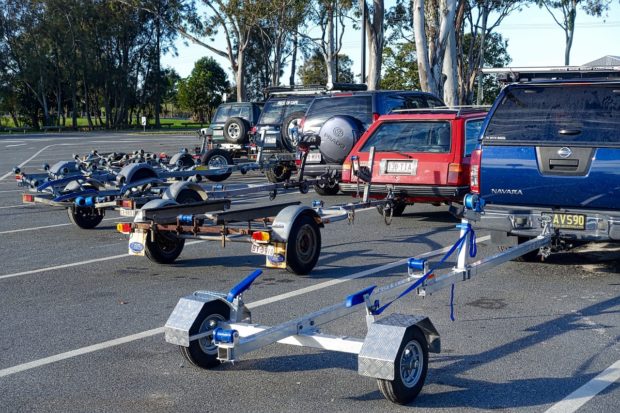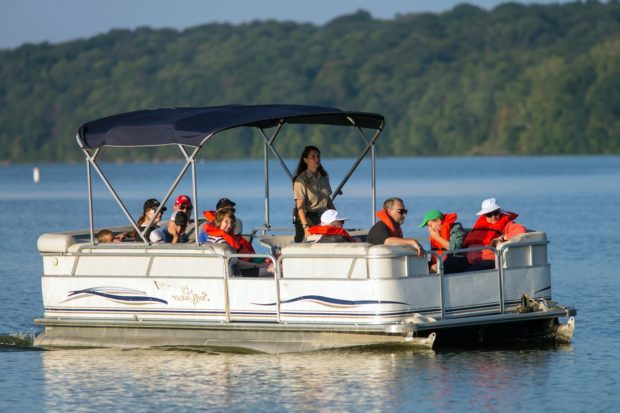Selecting the right pontoon trailer to fit a pontoon boat may look simple enough; however, many people, even professionals, make mistakes. Usually, boat owners would think that a 20-foot pontoon is for a 20-foot trailer. But this is not always the case. You must always yield to the side of caution. Let’s explore pontoon trailers for sale in GA.
The Right Size According to Trailer Manufacturers
Almost all pontoon trailer manufacturers rank their trailers according to boat size. Just a few examples are PT-20/13, PTB- 2023-10, PT-1925, WFB-120/10, and KDP-1820-27. If you’re unfamiliar with these, the first number is the boat’s length, while the next number indicates the trailer tire size, such as 10 inches, 12 inches, and 13 inches.

The following number may stand for the trailer’s capacity or carrying capacity, such as 23-2300 pounds, 25-2500 pounds, 27-2700 pounds, and so on. The examples we mentioned above are around 23 to 25 feet long. Meanwhile, the KDP trailer is meant for 18 to 20 feet boats, whereas almost all trailers can accommodate 18 to 21-foot long pontoons.
Choose a Trailer Longer Than the Boat
You must select a trailer that’s longer than your pontoon boat. This will give you just enough swinging radius when you’re making a right turn. For example, if the pontoon trailer is 20-foot extended, then the front of the 20-foot boat may hit the back of your vehicle when you make a right turn. This is also the reason why you should pick a pontoon trailer that’s 3 to 4 feet longer than the boat.
Considering this rule, if you have a 20-foot boat, you should get a 23 to 24-foot trailer. For a 24-foot pontoon boat, you must use a 27 to a 28-foot trailer and so on. If you’re unsure about the size of your pontoon, take a measuring tape and measure from tip to tip. Also, it would help if you referred to your owner’s manual.
Consider The Size of the Bunk
Some trailer manufacturers make use of wooden boards lined with carpet. This is placed in between the pontoon and the trailer for added support. The industry calls these bunks, so when buying a pontoon trailer, you need to include the size of the bunk for a trailer that will fit well.

Trailers to match 20-foot boats require bunks from 14 to 18-foot long. This is just the right size as the nose cone of pontoons tends to angle up. Just imagine the bow of a canoe. The trailer will be unable to support the pontoon beyond this angled area, and thus, there’s no need to place a bunk along the nose cone. Instead, all the weight of the boat will be placed on the stern.
How to Check If You Have a Good Fit Trailer?
To find out if your trailer and your pontoon are a good fit, check the back. Almost all of the weight of a pontoon boat is placed on the stern; this includes the captain’s helm, engine, gas tanks, and others. With this in mind, the back ends of the tubes should never be more than a foot from the back of the trailer.
A good fit is a boat with at least 3 feet of more overhang. Poorly fitting trailers can affect overall balance and tip-off tongue weight. Go with completely adjustable trailers to old pontoon models and new ones.
New boats manufactured after 2008 are mostly 8 feet and 6 inches wide, so they are adjusted to 77 inches center. Always remember, there’s no right or wrong size, and 72 to 77 inches are the best take. If you want the best fit, consider the center to center distance. Move the bunks for a better fit, or you can take your trailer to a dealership or manufacturer for the best results.
Some trailers can accommodate pontoons with varying lengths. This is done by sliding the trailer winch stand forward or to the back for 2-foot adjustability. This type of trailer can accommodate boats of 18, 21, 22, or 24 feet in length. Always be careful when adjusting the winch stand to ensure the correct tongue weight.
In some cases, manufacturers use winch stands for larger diameter boats (23 to 27 inches). It would help if you also considered the proper height of the winch stands for the pontoons. Remember, the best fit is when the pontoon hits the winch stand on its most vital point.
How to Tell If You Have a Poorly Fit Trailer?
A poorly fit trailer won’t provide good clearance for your pontoon. Also, your trailer won’t balance, and it’s impossible to maintain the correct tongue weight.
You can tell that it’s not a good fit even if you’re unaware of the trailer size. The winch stand is not in place with incorrect trailers. Also, the tube may be too far back or too much at the front. It’s easy to avoid these mistakes. Just make sure that you order the right pontoon trailer for your boat. Measure your pontoon or refer to the owner’s manual for the boat’s correct dimensions.
Conclusion
By using a pontoon trailer that fits well with your boat, you can guarantee the safety and stability of your pontoon during transport. Also, the right size trailer will give you years upon years of good use. Consider these tips, and you’re ready to take home the most suitable trailer for your pontoon in no time.
